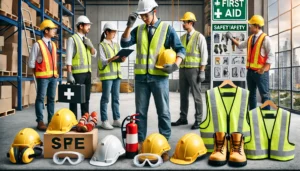Choosing the right Personal Protective Equipment is important for the health and safety of employees in many industries (PPE). PPE London is used to shield the employees from many potential health risks and occupational diseases. Using the wrong type of PPE would lead to injuries and even illnesses. Each business has specific circumstances and requirements that must be taken into account when PPE is selected.
Identifying Possible Hazards at the Workplace
The first step becomes conducting, as carefully as possible, a workplace obstacle assessment to the area where the employees will be working. While doing so, the following elements such as chemicals, biological elements, physical injuries, and environmental impacts have to be carefully evaluated. Based on the information gained from the specific hazards involved, the required PPE that needs to be used will be established.
Categories and Importance of PPE
1.Head Protection: These include but are not limited to hard hats and helmets which are employed to protect against any injuries that may result from falling objects or collisions with fixed features of the building. Construction and mining industries are probable areas of application.
2.Eye and Face Protection: Goggles, safety glasses, and face shields are also included to protect from chemicals, flying pieces, and even radiation. In manufacturing, laboratories, and even welding sectors, PPE ensures face and eye protection.
3.Hearing protection: One way of preventing loss of hearing is the use of earplugs and earmuffs in high decibel areas such as factories and sites under construction.
4.Respiratory Protection: For healthcare workers, painters, and those who deal with chemicals, respirators and masks are a must to avoid breathing toxic dust, fumes, vapor, or even pathogens.
5.Hand Protection: Temperature changes, cuts, abrasions, or exposure to chemicals are some of the dangers that gloves can protect against. It is however important to match the glove material with the kind of hazards the workplace has.
6.Body Protection: When dealing with chemical spills, heat, or biological contaminants, clothing such as lab coats, body suits and aprons can be used to protect one’s body. There are laboratories and chemical plants that require the use of such body protection.
7.Foot Protection: Protective shoes and safety boots with slip-resistant soles and toe caps are used to protect one from slipping and falling objects. In construction and warehousing, foot protection is a must.
Things to consider while choosing PPE
Regulatory Compliance: Check that the chosen PPE does not violate laws and policies of the industry. There are guidelines set by OSHA that help to determine whether adequate protection is guaranteed by a piece of equipment designed for such.
The Correct Fit and Comfortability: Any piece of Personal protective equipment should have a proper fit if it is to serve its purpose. Items that do not fit appropriately may pose a risk to safety while also creating possible reasons for employees to avoid wearing them as often as they should. Providing people with different size options and making certain parts of the equipment adjustable could increase comfort and increase the likelihood of using them.
Compatibility of Equipment: Where more than one type of Personal protective equipment is put on, their usage together should not be in conflict and sufficient restraint from having adverse effects on one another’s performance. For example, safety spectacles are supposed to be worn comfortably beneath face shields or over helmets.
Durability and Maintenance: Consider the durability of the PPE and the maintenance it requires. Reusable PPE should be easy to clean and maintain without compromising its protective qualities.
Employee Training: Education to provide and guides to use the Personal protective equipment is of great value. Staff need to know the procedures for donning and doffing the equipment and its significance for their safety.
Establishing a PPE Program
Building a comprehensive PPE program requires completing several important factors:
1.Risk Assessment: Periodically evaluate work locations for ever changing conditions and the hazards presented, and PPE that would be required to prevent such hazards.
2.Selection of PPE: Select equipment and safeguards that will provide the necessary level of protection without creating undue discomfort for the users.
3.Education and Training: Issue training for proper doffing and donning, cleaning, and the limitations of the equipment.
4.Maintenance and Inspection: Procedures in place for regular inspections and cleaning of PPEs and removals of non-functional PPEs.
5.Program Evaluation: The PPE program will be assessed for compliance to the standards from time to time.
Conclusion
Choosing the right PPE is very important in ensuring safety in the workplace. Possessing a thorough risk assessment, understanding types of PPE, compliance to policies, comfort during working, and other considerations will enable employers to offer adequate protection to their employees. Employers should adopt a well-designed organizational level PPE program with training and exercises towards evaluation to ensure safety and health at work in every industry.










